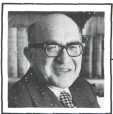 |
Home | Search | Browse | About IPO | Staff | Links |
 |
Home | Search | Browse | About IPO | Staff | Links |
  By MILTON RAKOVE By MILTON RAKOVEEast St. Louis EDITOR: I want to applaud Illinois Issues for having the courage to present such a well-written article by Mr. Ben Dobbin on East St. Louis. His graphic description of the problems of East St. Louis is very, very perceptive. The people described are representative of East St. Louis; they are the type of people serviced by our agency which houses the Hope Project. What Mr. Dobbin has not mentioned is the impact that the withdrawal of federal and state support will have on a city like East St. Louis. It is shocking that the State of Illinois would fail to totally commit itself to the development of an area that is blessed with waterways, highways, railways and a labor-intensive population. It is also shocking that such a situation can exist in St. Clair County, where there are numerous opportunities to improve the life of many of the citizens mentioned in your article. Kelvin L. Ellis On Mr. Krohe EDITOR: I simply want to tell Mr. Krohe how much I have enjoyed his articles in recent editions of Illinois Issues. By writing so thoroughly and so well about concerns that are of importance to the state, he is making a real contribution to better planning and decision making. In (he process, he is also helping to make Illinois Issues a magazine to be reckoned with. Rodney E. Engelen THE CHICAGO City Council has completed its decennial task of redistricting the city's 50 wards for the 1983 aldermanic elections. The completion of that task was both a manifestation of the council's futility and an affirmation of the enhanced power of Mayor Jane Byrne vis-a-vis the 50-person aldermanic body. By law, the council is charged with the task of preparing the ward map for the representation of Chicago's declining and changing population. The city has lost about 360,000 people since the 1970 census and has declined from a peak of 3,600,000 in 1950 to 3,000,000 in 1980. The black population in that 30-year period increased from 400,000 to 1,300,000. And the Latino population, which was negligible in 1950, totaled about 420,000 in 1980, if the census figures can be believed. Most sophisticated observers of the Chicago scene believe that the Latino population is really somewhere between 4/January 1982/Illinois Issues
|